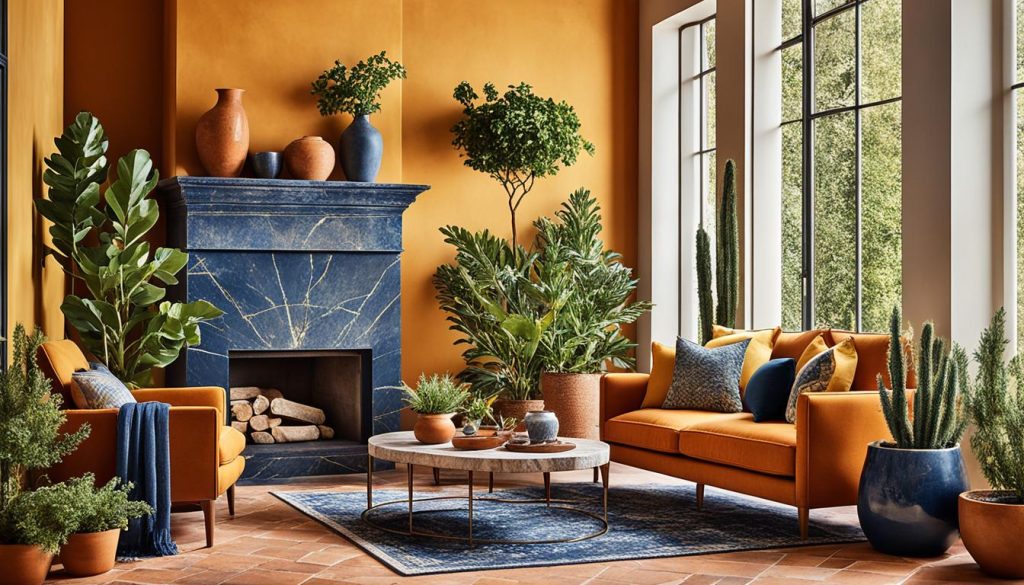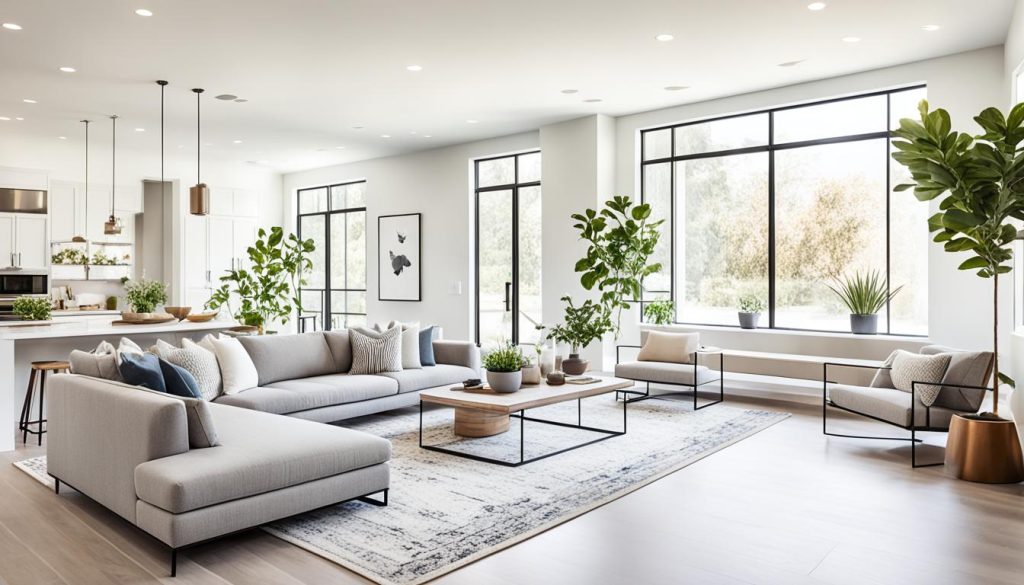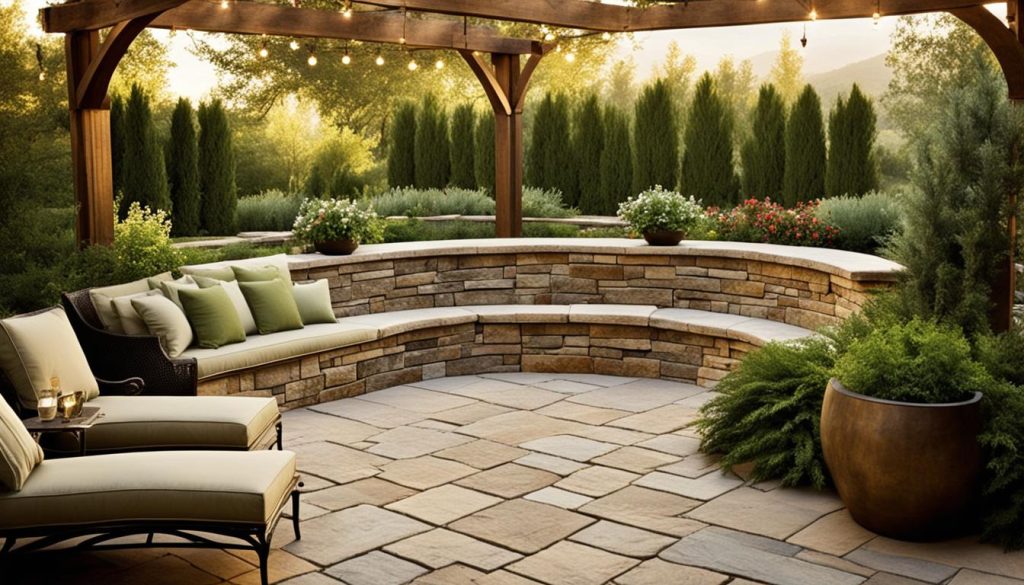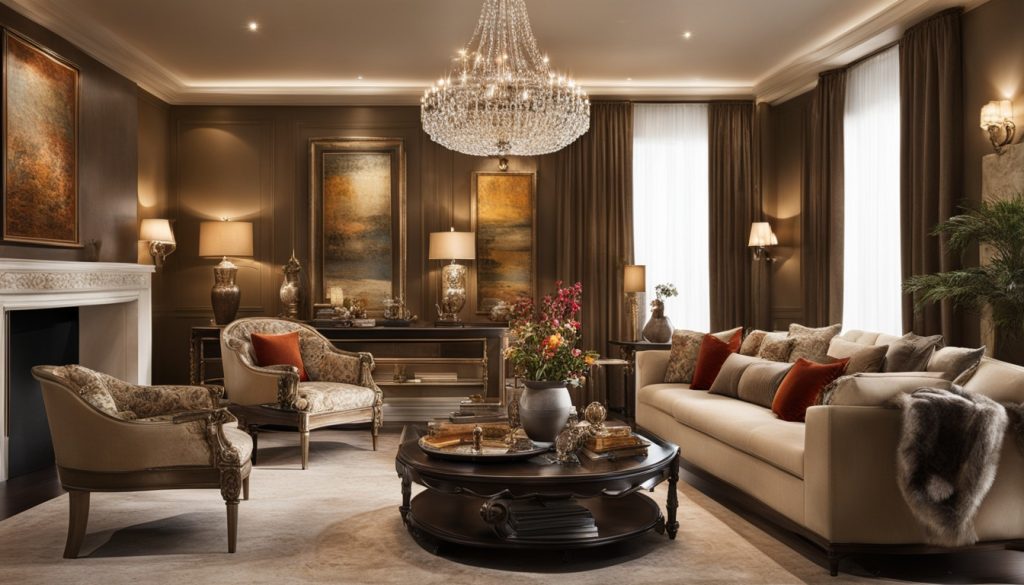We’re diving into the latest in Italian interior design for 2023. Get ready to see how elegant and chic styles can make your home look sophisticated and timeless.
Key Takeaways
- Italian interior design trends for 2023 bring elegance and sophistication to your home.
- Embrace natural elements and bring the outdoors in for a fresh and harmonious atmosphere.
- Choose a colour palette that combines rich neutrals with pops of vibrant hues for a balanced look.
- Incorporate luxurious furniture and materials with timeless appeal.
- Create open concept living spaces that promote a sense of openness and flow.
The Essence of Italian Interior Design
Italian interior design is known for its unique mix of Italian design principles, Italian aesthetics, and timeless elegance. It’s famous for making luxurious and sophisticated spaces. These spaces show refinement and harmony.
Italian design values craftsmanship and detail. They love quality materials and fine finishes. This shows in their furniture and lighting, where every detail is carefully done.
Italian aesthetics mix tradition with innovation. They keep classic elements but add modern touches. This makes their designs timeless yet modern, showing the true Italian style.
Italian design aims for luxury and opulence. It uses rich fabrics and ornate furniture to create grand spaces. These elements make the spaces elegant and indulgent.
Functionality is key in Italian design, but beauty is not ignored. Each piece is chosen for its purpose and fits well with the design. This makes Italian interiors beautiful and practical.
The Italian Design Process
The design process in Italy is detailed and careful. Designers plan and execute with great skill. They focus on every detail, from space layout to material choice.
Creating a cohesive space is important to Italian designers. They consider color, lighting, and furniture placement. This ensures a smooth look that boosts the design’s beauty.
Italian designers get inspiration from their culture, architecture, and nature. This adds depth to their designs, making them visually stunning and historically rich.
Italian interior design is more than making beautiful spaces. It’s about the art of living. It offers a timeless beauty that invites people to enjoy the elegance of Italian design.
Influences from Italian Architecture
Italian interior design draws a lot from Italy’s rich architectural past. The beauty of Renaissance palaces and the grand Baroque structures have greatly influenced Italian interior styles. These styles have shaped the look and feel of Italian interiors.
The Renaissance
The Renaissance, from the 14th to the 17th century, changed Italian architecture a lot. It was inspired by ancient Greek and Roman designs. This led to a focus on balance, harmony, and proportion in architecture.
This focus is seen in Italian home interiors. They feature elegant lines, symmetrical layouts, and a timeless beauty.
The Baroque Era
After the Renaissance, the Baroque period added a lot of luxury to Italian architecture. Baroque interiors were full of lavish decorations and intricate details. They had a theatrical feel.
Italian designers took inspiration from the grand palaces and churches of this time. They used rich fabrics, ornate furnishings, and detailed ceiling frescoes. This created a dramatic and luxurious look.
Understanding Italian interior design means knowing its historical roots. By using elements from the Renaissance and Baroque, designers make spaces that are elegant, sophisticated, and uniquely Italian.
Colour Palette and Tonal Harmony

In Italian interior design, choosing colours is very important. Italian colour schemes are known for making spaces feel warm, peaceful, and harmonious. They use warm tones and earthy hues to create a timeless elegance that feels welcoming and calming.
Warm tones like rich terracotta, deep ochre, and soft beige are common in Italian interiors. These colours remind us of the sunny landscapes of Tuscany, bringing natural beauty inside.
Earthy hues, such as deep olive greens and warm browns, are also key in Italian design. These colours add depth and a sense of connection to nature. They can be used in walls, furniture, and accessories to add an Italian feel.
Tonal harmony is a big part of Italian design. It’s about blending colours smoothly to get the right look. Whether mixing warm neutrals with earthy tones or adding bright jewel colours, it’s all about balance and beauty.
Let’s look at some examples of Italian colour schemes and tonal harmony:
Example 1: Brinjal Dreams
| Colour | Description |
|---|---|
| Brinjal | A rich, deep purple with warm undertones. Creates a luxurious, elegant ambiance. |
| Bronze | A warm, metallic hue that adds a touch of opulence to the space. |
| Amber | A golden yellow shade that radiates warmth and creates a welcoming atmosphere. |
This example shows how brinjal, bronze, and amber work together to make a sophisticated and warm palette. These colours can be used in walls, furniture, and accessories to make a room feel cohesive and inviting.
Example 2: Tuscan Escape
| Colour | Description |
|---|---|
| Terra Cotta | A warm, earthy tone reminiscent of the Tuscan countryside. Adds a rustic charm to the space. |
| Olive | A deep, rich green that brings a sense of nature and freshness to the environment. |
| Amaretto | A warm, caramel-like shade that adds a touch of sweetness to the room. |
Using terra cotta, olive, and amaretto, the design captures the essence of a Tuscan escape. These colours can be used alone or together to create a warm, inviting space that feels like Italy.
Choosing and combining colours carefully, along with tonal harmony, are key to an Italian-inspired interior. By using warm tones, earthy hues, and a balanced palette, you can make a space that’s elegant, peaceful, and full of Italian charm.
Luxurious Furniture and Materials
Italian interior design is famous for its elegance and sophistication, especially in furniture and materials. Italian furniture combines artistry, craftsmanship, and functionality. This results in pieces that look great and last long.
The craftsmanship in Italian furniture is unmatched. Artisans focus on every detail to make each piece a masterpiece. They use traditional techniques and modern innovation for beauty and function.
Italian furniture uses luxury materials like fine woods, metals, and leathers. The choice of materials adds to the furniture’s allure and quality. Whether it’s a wooden dining table, metal coffee table, or leather sofa, it feels luxurious and sophisticated.
High-quality fabrics are a key part of Italian interior design. Fabrics like velvet, silk, and chenille are used in upholstered furniture. These fabrics add luxury and make the furniture more comfortable and durable.
To see the beauty of Italian furniture and materials, look at this table. It lists famous Italian furniture brands known for their great craftsmanship and materials:
| Brand | Description |
|---|---|
| Poltrona Frau | Renowned for their impeccable leather craftsmanship and iconic designs. |
| B&B Italia | Combines innovation, design, and high-quality materials to create cutting-edge furniture pieces. |
| Molteni&C | Known for their timeless designs and use of premium woods and fabrics. |
| Flexform | Exemplifies Italian craftsmanship through their elegant furniture pieces and attention to detail. |
These brands show the essence of Italian furniture design. They mix luxury, craftsmanship, and detail perfectly.
Note: The image above shows a luxurious Italian furniture piece. It adds visual appeal and fits the topic of luxurious furniture and materials.
Classic Italian Design Elements
Classic Italian design is known for its timeless beauty and rich look. It uses ornate details, intricate patterns, and beautiful plasterwork. These elements make spaces look grand and sophisticated.
Ornate details are a key part of classic Italian design. Furniture and decorations are adorned with detailed carvings and moldings. This shows the skill and care put into each piece.
Intricate patterns are also important. They add depth and interest to the design. You can see these patterns on furniture, wallpaper, and even ceilings.
Plasterwork is another highlight of classic Italian design. It includes fancy cornices and ceiling medallions. These add a sense of luxury and make the space feel special.
Exquisite Handcrafted Furniture
Italian furniture is famous for its quality and detail. Classic Italian design celebrates handcrafted furniture with beautiful carvings and luxurious fabrics. Each piece is a masterpiece that brings elegance to any room.
Stunning Murano Glass
Mentioning Murano glass is essential when talking about classic Italian design. Made on the island of Murano, it’s known for its vibrant colors and detailed designs. Murano glass chandeliers and vases are highly valued for their beauty.
Timeless Marble
Marble is a favorite in classic Italian design. Its beauty, elegance, and strength make it perfect for floors and decorative pieces. Marble adds luxury and class to any area, whether it’s a fireplace or a staircase.
Sumptuous Fabrics
Classic Italian interiors love luxurious fabrics. Velvet and silk add comfort and luxury. Fabrics with intricate patterns like damask and brocade make the space feel even more opulent.
Classic Italian design shows off timeless beauty and skill. With its detailed designs and stunning plasterwork, it creates spaces that are enchanting. Adding these elements to your home brings Italian elegance and sophistication.
Embracing Natural Elements
Italian interior design is famous for mixing luxury with sustainability. It uses natural elements to make spaces look better and be more sustainable.
Designers use natural materials like stone, wood, and textiles. These add warmth and authenticity to a room. They also look elegant and are better for the planet than synthetic options. By picking materials that are local and sustainable, designers help the environment and stay connected to nature.
Italian design also brings nature inside with biophilic elements. This means adding plants and natural light to indoor spaces. It helps people feel close to nature, even in cities. Using big windows and skylights cuts down on artificial lighting and connects us to the outdoors.
Designers also focus on organic and eco-friendly finishes. They choose paints and coatings with fewer harmful chemicals. This makes the living space healthier for everyone.
Benefits of Embracing Natural Elements
Using natural elements in design makes people feel better. Being around natural materials and plants lowers stress and boosts brain function. It also makes people feel more at home and connected to their space.
This approach also means using resources wisely, creating less waste, and lowering the space’s carbon footprint. By choosing natural and sustainable materials, Italian designers help protect the environment for the future.
| Natural Materials | Benefits |
|---|---|
| Stone |
|
| Wood |
|
| Textiles |
|
Natural elements are key to Italian interior design. They create spaces that are beautiful and good for the planet. By using natural materials and sustainable practices, designers make spaces that look great and are kind to the earth.
Open Concept Living Spaces

Italian interior design loves open concept living spaces. These designs make rooms flow together smoothly. This makes the home look better and work better too.
Open plan layouts remove walls to connect different parts of the house. This lets family members move easily between activities. They can still talk and see each other, making the home feel more connected.
Designers in Italy are experts at planning these spaces. They arrange furniture and decor in a way that makes moving between areas easy. Yet, each area still has its own special feel.
Using furniture and lighting helps define different areas in an open plan. For instance, an area rug can mark the living room. Pendant lights above the dining area can show where that is.
Creating Seamless Transitions
For smooth transitions, keep the design consistent throughout the home. Use the same colors, materials, and styles in all areas. This makes moving from one room to another feel natural.
For example, if the living room has a neutral look with wood and stone, use these in the dining and kitchen too. This keeps the look flowing and makes the home feel connected.
| Open Plan Living Benefits | Challenges to Consider |
|---|---|
| 1. Enhances natural light and creates an airy atmosphere | 1. Limited privacy, especially in shared spaces |
| 2. Allows for easy interaction and communication between family members | 2. Requires thoughtful acoustic planning to minimize noise transfer |
| 3. Provides flexibility in furniture arrangement and space utilization | 3. Requires meticulous organization to maintain a clutter-free appearance |
| 4. Maximizes the perceived size of the living space | 4. Can pose challenges when it comes to HVAC and temperature control |
Choosing an open concept living space means thinking about its pros and cons. It’s key to balance the open feel with the need for privacy and function.
In Italian homes, open concept living spaces show how areas blend together smoothly. This design makes the home look great and work well. It also makes the space welcoming and peaceful.
Statement Lighting Fixtures
Lighting is key in Italian interior design, making a space feel welcoming and stylish. Italian lighting is famous for its beautiful craftsmanship. It offers many statement fixtures that make any room look better.
Chandeliers
Chandeliers bring a sense of luxury to Italian rooms. They have detailed designs, shiny crystals, and fancy materials. Whether they have crystal drops or candlelights, they become the main attraction in any room.
Pendant Lights
Pendant lights mix style with function, adding a modern touch to Italian interiors. They hang from the ceiling, lighting up areas like dining tables or kitchen islands. You can find pendant lights in many designs and materials, from glass to metal.
Table Lamps
Table lamps are great for both lighting and decoration. They often have beautiful designs, like fancy bases or ceramic patterns. These lamps sit on side tables or bedside tables, giving off a warm light.
Floor Lamps
Floor lamps are eye-catching, adding to a room’s look and providing enough light. Italian floor lamps have many styles, from modern to classic. They can light up a living room corner or highlight a reading spot, bringing elegance to any area.
When choosing lighting for your Italian-style home, think about the overall look you want and the mood you want to create. Whether it’s a grand chandelier or a modern pendant light, the right lighting can really make your space stand out.
Textures and Patterns
Italian interior design is famous for its eye for detail. It uses textures and patterns to make spaces visually stunning. These elements bring depth and character to any room.
Italian textiles are known for their fine craftsmanship and luxurious feel. They are often used for upholstery, curtains, and cushions. This adds elegance and sophistication to a room. The rich textures and patterns make the space feel warm and inviting.
Textured surfaces are another key feature of Italian design. They add depth and dimension to walls. Whether it’s a subtle stucco finish or bold wallpaper, these surfaces invite touch and draw the eye.
Patterned fabrics are also important in Italian design. They can be bold or delicate, adding visual interest. These fabrics are used for curtains, upholstery, and decorative accents. Mixing different patterns creates a vibrant and dynamic space.
Intricate wallpapers are used to add grandeur and sophistication. They feature elaborate patterns and designs. From classic damask to whimsical botanical prints, these wallpapers turn walls into art. They add drama and elegance to any room.
Using Italian textiles, textured surfaces, patterned fabrics, and intricate wallpapers makes your interior visually captivating. These elements enhance the aesthetic and create a unique space that reflects your style.
Minimalism with a Touch of Opulence
In recent years, minimalist Italian design has become popular. It combines clean lines and simplicity with a bit of luxury. Italian interiors have found a perfect balance between minimalism and luxury. They do this with curated collections and carefully chosen furniture.
Minimalist Italian design aims to create calm and harmonious spaces. It focuses on simplicity and functionality. Clean lines bring a sense of order and peace to the room. This style encourages a clutter-free space, where every item has a purpose.
High-quality materials and finishes are key in minimalist Italian design. Luxury is shown through the use of marble, fine woods, and luxurious fabrics. Each piece is picked to add to the overall look, creating a refined elegance.
Curated collections are crucial in minimalist Italian design. Every item in the space is chosen to work well with others. This focus on quality over quantity lets each piece stand out and enhance the room’s feel.
Simplicity and Functionality
Minimalist Italian design values functionality and style equally. Furniture is sleek and serves its purpose well. It fits perfectly with the design. Using multi-functional furniture and smart storage keeps the space tidy and organised.
Elegant Colour Palettes
The colours used in minimalist Italian design are soft and calming. Shades of white, beige, gray, and earth tones are common. These colours create a peaceful setting and let the design’s clean lines and curated pieces be the focus.
Subtle Accents of Opulence
Minimalism is the base of Italian interior design, but a bit of luxury is added with special touches. This could be a standout light fixture, a piece of art, or a luxurious fabric used sparingly. These touches add richness and sophistication to the design.
| Elements of Minimalist Italian Design | Examples |
|---|---|
| Clean lines | Linear furniture designs |
| Natural materials | Marble countertops |
| Neutral colour palette | Beige and gray tones |
| Curated furniture collections | Meticulously chosen statement pieces |
| Functional storage solutions | Built-in shelves and hidden compartments |
Outdoor Living and Relaxation

Italian interior design focuses on making indoor and outdoor spaces flow together smoothly. This creates beautiful Italian outdoor spaces that feel like part of the home. These areas are designed with nature in mind, featuring garden design, alfresco dining, and relaxation areas.
Italian gardens are famous for their stunning beauty and balance with nature. They have lush greenery, neat hedges, and calm water features. These elements make the gardens peaceful places for rest and refreshment. There are perfect spots for enjoying the breeze and the beauty of nature.
Alfresco dining is a big part of Italian life. Italian outdoor areas are made for this, with lovely courtyards, big terraces, or gardens. They have dining tables, chairs, and even outdoor kitchens. Eating outside with great food, friends, and a magical setting is unforgettable.
For those who love to relax, Italian outdoor spaces have special areas for it. You might find a quiet garden spot with a comfy chair, a hammock under a tree, or a fountain. These places offer a peaceful escape.
Creating an Italian Outdoor Oasis
When making your own Italian outdoor space, think about using natural materials like stone, wood, and terracotta. Add plants, flowers, and vines to bring nature into your space.
Having a great outdoor dining area is key for family meals and parties. Choose a strong dining table and chairs that look good and last long. Consider a pergola or awning for shade and protection from the weather.
For relaxing, pick furniture that’s comfy and lasts a long time. Go for lounge chairs, hammocks, or hammocks for chilling out. Add things like fire pits, water features, or soft lights to make it even more relaxing.
| Italian Outdoor Living Essentials | Features |
|---|---|
| Garden Furniture | Comfortable and stylish seating options |
| Dining Area | Durable table and chairs for alfresco dining |
| Shade Structures | Pergolas, umbrellas, or retractable awnings |
| Water Features | Fountains, ponds, or small waterfalls |
| Lighting | Soft ambient lighting for a cozy atmosphere |
| Greenery | Potted plants, trees, and flowers |
With these elements, you can make your own Italian outdoor oasis. It will be a place where you can enjoy the outdoors and feel the beauty of your home’s design.
Incorporating Art and Sculptures
Italian interior design is famous for blending art and sculptures beautifully. This makes spaces feel like galleries. Italy is known for its rich artistic history, creating some of the world’s most famous art pieces. This section looks at how Italian art and sculptures can make your home special.
Adding Italian art to your home shows you value history, culture, and skill. It ranges from old masterpieces to modern art, adding elegance and creativity. Sculptures are key in Italian design, adding depth and character to rooms.
Inspiration from Art Galleries
For those wanting to highlight sculptures, look to art galleries for ideas. Create a gallery-like area for your sculptures. Use simple pedestals or stylish plinths to make them stand out and be the room’s focus.
Choosing art pieces means picking ones that match your style and the room’s look. Aim for sculptures that stir feelings and tell stories, showing off your unique taste.
Integrating Art with Existing Decor
Adding art and sculptures doesn’t mean a complete redecoration. Blend them with your current decor. Think about the colours, textures, and materials in your space. Pick sculptures that match these, making everything look good together.
Adding statement pieces can spark conversations and improve a room’s feel. Put sculptures in eye-catching spots, like on a console table or at the entrance. This makes the space more sophisticated.
Italian art and sculptures can turn any interior into something special and beautiful. Whether you prefer Renaissance or modern art, adding these pieces will take your design to the next level.
Contemporary Italian Interior Design
Italian interior design combines modern elements with a unique style. It draws from the country’s rich art, culture, and architecture. This blend creates a captivating look with sleek lines and innovative materials.
Sleek lines are a key feature of this design. They make spaces feel fluid and harmonious. Furniture, lighting, and architecture all benefit from these clean lines, adding elegance.
Designers love to use new materials like glass, metal, and acrylic. These materials add a modern touch to designs. They make the spaces look fresh and striking.
Modern aesthetics are central to this design. It focuses on simplicity and functionality. The goal is to create spaces that are clean and let the design speak for itself. Neutral colors and natural light are used to enhance the look.
This design also respects Italy’s architectural past. Classic elements like grand arches are updated for today. This connects the old with the new beautifully.
The furniture in contemporary Italian design is both beautiful and practical. Each piece is made with care, ensuring comfort and style. This makes the furniture both stunning and useful.
Art and sculptures are also key in this design. They add depth and character to a room. These pieces become the focal points, making each space unique.
Contemporary Italian design brings together modern and traditional elements. It offers a sophisticated and elegant look. This makes it a top choice for those wanting a refined interior.
| Key Elements of Contemporary Italian Interior Design |
|---|
| Sleek lines |
| Innovative materials |
| Minimalist forms |
| Integration of art and sculptures |
| Harmony between modern aesthetics and traditional craftsmanship |
Bringing Italian Design into Your Home
Want to add a bit of Italian style to your home? Here are some easy tips for bringing Italian-inspired interiors into your space. Whether you’re on a budget or planning big changes, these ideas will help.
1. Embrace Earthy Tones and Warm Neutrals
Italian design loves earthy tones and warm neutrals like beige, terracotta, and olive green. Paint your walls these colours or use them in furniture and decor. This makes your home feel warm and welcoming, like the Italian countryside.
2. Choose Timeless Furniture Pieces
Invest in furniture that’s both elegant and timeless. Look for pieces with clean lines and quality craftsmanship. Furniture made from natural materials like wood, leather, and stone is a good choice. These pieces will last long and add luxury to your home.
3. Integrate Italian Art and Sculptures
Add some art and sculptures to your home for a touch of Italian flair. Hang paintings or prints by famous Italian artists like Leonardo da Vinci or Michelangelo. Display sculptures inspired by Italian masters to add sophistication.
4. Incorporate Natural Elements
Italian design celebrates nature. Bring the outdoors in with natural elements. Use plants to freshen up your space. Add stone, marble, or wood for a rustic yet elegant look. This brings a calm and peaceful feel to your home.
5. Dress Your Windows with Luxurious Fabrics
Italian interiors often feature luxurious curtains or drapes. Choose high-quality fabrics like silk or velvet. Pick rich colours or patterns that show off Italian style. These window treatments add luxury and enhance your home’s look.
6. Create a Cozy Reading Nook
Italian design is all about comfort. Set up a cozy reading nook in your home. Pick a comfy armchair with plush cushions and a side table for your books and espresso. Add a throw blanket and a floor lamp for the perfect spot to relax with a book.
7. Light up Your Space with Statement Lighting
Lighting is key in Italian design. Use statement lighting fixtures that reflect Italian style. Chandeliers, pendant lights, and wall sconces with intricate designs and luxurious materials can make any room special. Let lighting be a highlight and add grandeur to your home.
With these tips, you can easily add Italian design to your home. Whether you’re making small changes or redoing your space, Italian-inspired interiors will bring timeless elegance to your home.
Conclusion
Italian interior design is all about elegance and timeless style. It draws inspiration from Italian architecture. This design combines colours and a well-thought-out colour palette beautifully.
Whether you like grand, classic furniture or modern, simple styles with a hint of luxury, Italian design has something for everyone. It offers a wide range of choices to match any taste.
Adding natural elements, eye-catching lighting, textures, and patterns can make your home look amazing. You can also bring art and sculptures into your space for extra beauty.
Let Italian interior design add elegance to your home. It can take your living spaces to a whole new level.
















